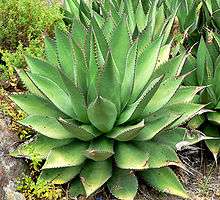Agave shawii
Agave shawii, with the common names coastal agave or Shaw's agave,[2][3] is a very rare and critically endangered[4] species in the genus Agave native to southwestern California and Baja California. The plant is named for Henry Shaw, the founder of the Missouri Botanical Garden.[5]
| Agave shawii | |
|---|---|
 | |
| Scientific classification | |
| Kingdom: | Plantae |
| Clade: | Tracheophytes |
| Clade: | Angiosperms |
| Clade: | Monocots |
| Order: | Asparagales |
| Family: | Asparagaceae |
| Subfamily: | Agavoideae |
| Genus: | Agave |
| Species: | A. shawii |
| Binomial name | |
| Agave shawii | |
| Synonyms[1] | |
| |
Distribution
The plant is native to California coastal sage and chaparral habitats, along the Pacific Coast of northern Baja California state of Mexico and southwesternmost San Diego County of California. It is much more common in the wild in Baja California than in San Diego County, where urban development has essentially wiped out the plant's native habitats.[6] In a preservation effort, Shaw's Agaves were introduced into the Torrey Pines State Reserve and Cabrillo National Monument in San Diego, California and have established themselves.[7] There is also large colony of Shaw's Agave in the San Diego Botanic Garden located in Encinitas, California with nearly 100 specimens. The San Elijo Lagoon Nature Center in Encinitas also has Shaw's Agaves planted as part of their California native plant xeriscaping. There are also some specimens in the cactus garden portion of Friendship Park, located on the border divide between San Diego and Tijuana, Mexico.
Description
Agave shawii is a very slow-growing, small-to-medium sized agave, with green ovate leaves 20–50 cm long and 8–20 cm wide, and a variable pattern of marginal teeth. When it blooms at the end of its life, the large, clubby inflorescence forms a panicle 2–4 meters in height, whose 8–14 lateral umbels are subtended by large purple bracts. Each umbel consists of a mass of yellowish or reddish flowers.
It generally flowers February to May, and as typical for agaves, the rosette dies thereafter. Although capable of reproducing by suckering, populations vary considerably in their behavior, with some consisting entirely of individual rosettes, while others form groups or colonies of clones.
Varieties and subspecies
- Agave shawii var. shawii [8]
- Agave shawii subsp. goldmaniana (Trel.) Gentry — generally larger, with longer (40–70 cm) lanceolate leaves, and 18–25 umbels on a 3–5 meter stem, and predominates in the desert of the central peninsula.
Cultivation
Agave shawii is cultivated as an ornamental plant, by specialty plant nurseries. It is used in cactus and succulent gardens, and for drought tolerant and wildlife gardens.
This agave species is frost tender, with damage starting at −5 °C and becoming extensive at −8 °C. Plants in containers have been able to survive 18 °F with no damage located on the Central Coast. Frost cloth has also allowed plants to survive well with temperatures well below freezing for long periods (days) without damage.
Plants enjoy a sandy loam soil that has good drainage. Roots are very rapid responders to rain and dry plants have been documented to start growing feeder (rain) roots within 3 hours after exposure to the rain. Plants are subjected to mealybug attack and systemic treatments should be used regularly. Plants develop best color when exposed to full sun along the coast. Some relief from the hot afternoon sun in the inland valleys would provide the best results for growers. A slow growing plant, the young may take 5 years to reach a good 2 gallon container size. Plants bloom from 30 years old on, with prolific pupping prior to dying post flowering. Seeds are best sown fresh with no stratification required.
References
- The Plant List, Agave shawii
- Engelmann, Georg. Transactions of the Academy of Science St. Louis 3:314, t. 2-4. 1875.
- Clark, K.B.; Dodero, M.; Chavez, A.; Snapp-Cook, J. (2008). "The threatened biological riches of Baja California's Colonet Mesa" (PDF). Fremontia. 36 (4): 3–10.
- California Native Plant Society http://www.rareplants.cnps.org/detail/75.html
- Starr, Greg. Agaves: living sculptures for landscapes and containers. Timber Press, 2012.
- Starr, Greg. Agaves: living sculptures for landscapes and containers. Timber Press, 2012.
- Ingram, Stephen. Cacti, Agaves, and Yuccas of California and Nevada. Cachuma Press, 2008.
- CalFlora: Agave shawii var. shawii
- Raymond M. Turner, Janice E. Bowers, and Tony L. Burgess, Sonoran Desert Plants: an Ecological Atlas (Tucson: The University of Arizona Press, 1995) pp. 63–65
External links
- Calflora Database: Agave shawii (Shaw's agave, coastal agave)
- Jepson eFlora treatment of Agave shawii
- USDA Plants Profile for Agave shawii (coastal agave)
- Agave shawii — UC Photos gallery
| Wikimedia Commons has media related to Agave shawii. |